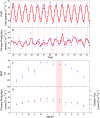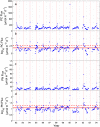Predictable and efficient carbon sequestration in the North Pacific Ocean supported by symbiotic nitrogen fixation
- PMID: 22308450
- PMCID: PMC3277559
- DOI: 10.1073/pnas.1120312109
Predictable and efficient carbon sequestration in the North Pacific Ocean supported by symbiotic nitrogen fixation
Abstract
The atmospheric and deep sea reservoirs of carbon dioxide are linked via physical, chemical, and biological processes. The last of these include photosynthesis, particle settling, and organic matter remineralization, and are collectively termed the "biological carbon pump." Herein, we present results from a 13-y (1992-2004) sediment trap experiment conducted in the permanently oligotrophic North Pacific Subtropical Gyre that document a large, rapid, and predictable summertime (July 15-August 15) pulse in particulate matter export to the deep sea (4,000 m). Peak daily fluxes of particulate matter during the summer export pulse (SEP) average 408, 283, 24.1, 1.1, and 67.5 μmol·m(-2)·d(-1) for total carbon, organic carbon, nitrogen, phosphorus (PP), and biogenic silica, respectively. The SEP is approximately threefold greater than mean wintertime particle fluxes and fuels more efficient carbon sequestration because of low remineralization during downward transit that leads to elevated total carbon/PP and organic carbon/PP particle stoichiometry (371:1 and 250:1, respectively). Our long-term observations suggest that seasonal changes in the microbial assemblage, namely, summertime increases in the biomass and productivity of symbiotic nitrogen-fixing cyanobacteria in association with diatoms, are the main cause of the prominent SEP. The recurrent SEP is enigmatic because it is focused in time despite the absence of any obvious predictable stimulus or habitat condition. We hypothesize that changes in day length (photoperiodism) may be an important environmental cue to initiate aggregation and subsequent export of organic matter to the deep sea.
Conflict of interest statement
The authors declare no conflict of interest.
Figures






References
-
- Field CB, Behrenfeld MJ, Randerson JT, Falkowski P. Primary production of the biosphere: Integrating terrestrial and oceanic components. Science. 1998;281:237–240. - PubMed
-
- Ryther JH. Photosynthesis and fish production in the sea. Science. 1969;166:72–76. - PubMed
-
- Martin JH, Knauer GA, Karl DM, Broenkow WW. VERTEX: Carbon cycling in the northeast Pacific. Deep-Sea Res Part A Oceanogr Res Pap. 1987;34:267–285.
-
- Volk T, Hoffert MI. In: The Carbon Cycle and Atmospheric CO2: Natural Variations Archean to Present. Sundquist ET, Broecker WS, editors. Washington, DC: American Geophysical Union; 1985. pp. 99–110.
-
- Legendre L, Rassoulzadegan F. Food-web mediated export of biogenic carbon in oceans: Hydrodynamic control. Mar Ecol Prog Ser. 1996;145:179–193.
Publication types
MeSH terms
Substances
LinkOut - more resources
Full Text Sources
Other Literature Sources
Miscellaneous

